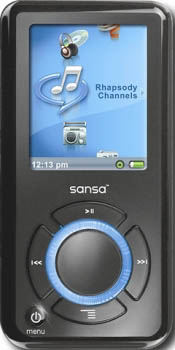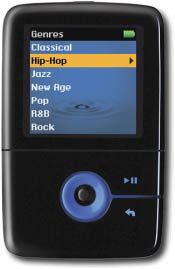
|
Although it’s taken a number of years to get to the point where there are now a few, half-decent mp3 players on the market to consider (despite the prominence and ubiquity of the Apple iPod), it’s now safe for consumers to walk in to their local Best Buy and purchase an mp3 player that will do pretty much everything they need it to do, from playing music and video, to voice recording, calendar work and everything in between.
The newest, and according to C|NET, best mp3 player is the 8GB SanDisk Sansa e280R Rhapsody, a flash-based mp3 player which (unlike its iPod competitor) includes an FM tuner, a voice recorder, access to music downloads through Rhapsody, a user removable battery, an expansion card slot, and great battery life.
They’re not calling the Sansa e280R an iPod killer for nothing.
Why buy SanDisk’s e280R, or Creative’s 4GB Zen V Plus — also a C|NET Editor’s Choice, just like its Sansa cousin  (and, in the interest of full disclosure, currently VanRamblings’ default mp3 player) — rather than one of the many hard drive-based mp3 players on the market?
The answer to that question is many. First off, battery life. Because it’s a flash-based player and there are no moving parts inside, battery life is two to four times as great as you’d experience with a hard drive-based player.
Next up, again because it’s a flash-based player (with no moving parts), whether it’s Sansa, Zen V or iPod Nano, it is pretty much indestructible.
Creative and SanDisk are one up on the iPod given that they play Microsoft’s proprietary WMA format, allowing for almost double the number of songs to be moved onto the player (up to 4000 mp3s on the e280R — and, really, how many people have more than 4000 songs they want to load onto their mp3 player, and carry around with them to the gym, the beach, or in the car?). Four thousand songs? Sounds great to me.

|
Both the 8GB SanDisk Sansa e280R Rhapsody and the 4GB Creative Zen V Plus (pictured right) offer a host of features at a price below $250.
Aside from the 1.5″ colour OLED display, it’s scratch resistant, has a built-in voice recorder and 32-channel FM tuner, you can play several different video formats, view photos and album art, record directly from a CD, play audio books — and the player is not only light (at barely 35 grams, or an ounce and a half), it’s portable and won’t skip no matter how hard a workout you give it (or yourself) at the gym or on the beach.




